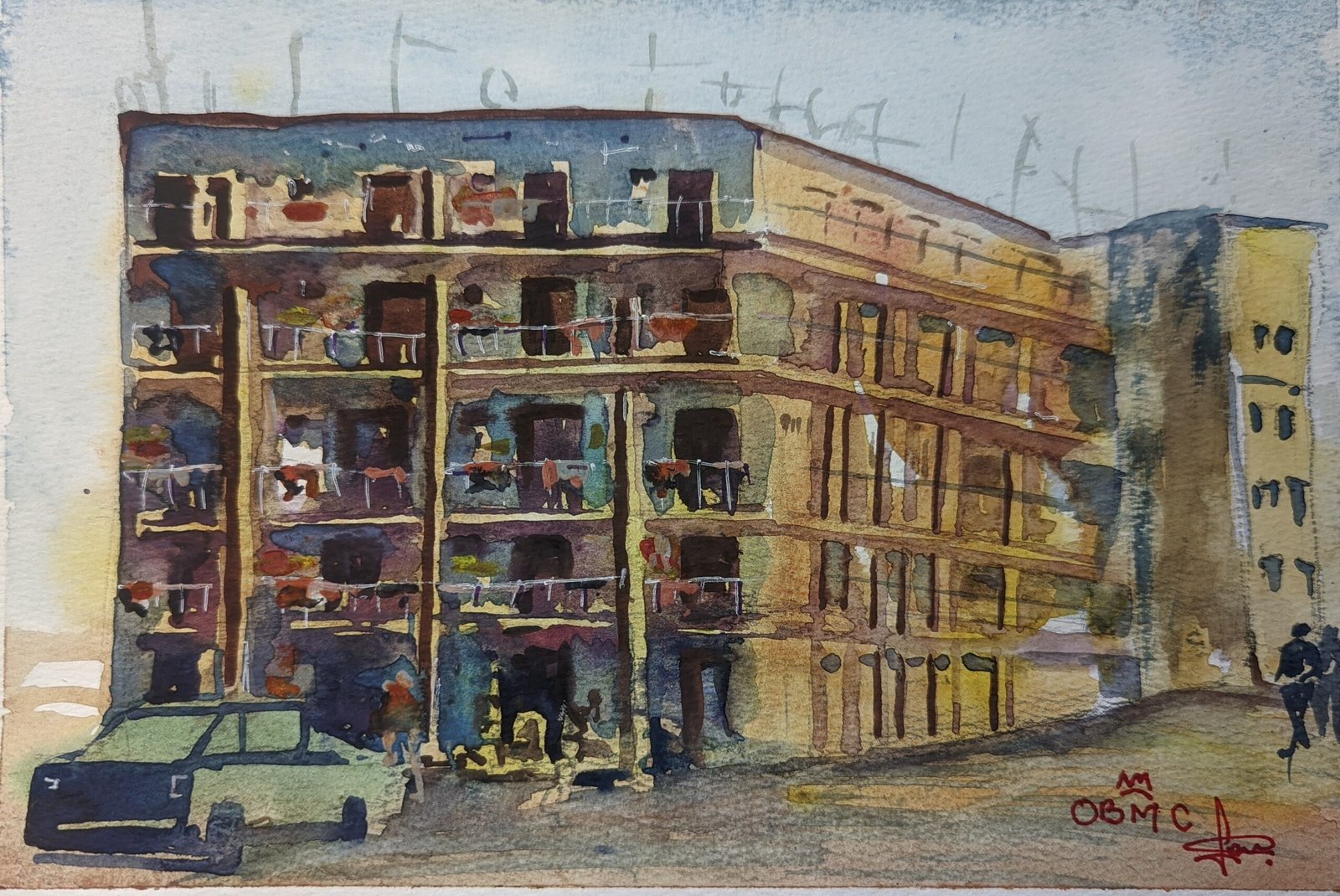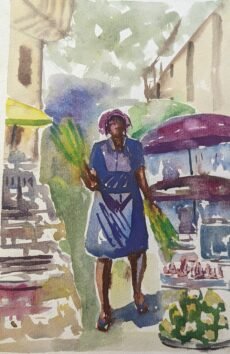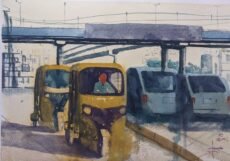Description
Art Description: “Civil Barrack” by OBMC
The artwork titled “Civil Barrack” by OBMC, a watercolor painting, captures the raw essence of urban overpopulation in a multi-story residential building. The structure, depicted in muted earth tones with splashes of blue and red, looms large in the frame, its weathered facade revealing the passage of time and neglect. The building’s balconies are cluttered with laundry, pots, and miscellaneous items, suggesting a dense, communal living space. On the ground level, a lone car and a few silhouetted figures hint at the constant movement of residents, while the faded sky above adds a somber tone to the scene. OBMC’s loose, expressive brushstrokes and the muted palette evoke a sense of struggle, resilience, and the weight of shared survival.
The Story of the Building and Its Residents
The building in “Civil Barrack” tells a story of necessity, survival, and the harsh realities of urban poverty. This multi-story structure, likely situated in a densely populated city, houses dozens of families and individuals crammed into small, subdivided units. The residents share a single, overused toilet, a stark symbol of their limited resources and the compromises they’ve been forced to make. The air is thick with the sounds of daily life—children crying, neighbors arguing, and the clatter of shared cooking spaces—yet there’s an unspoken camaraderie among the tenants, bound by their shared circumstances.
Hardships Leading to Such Living Conditions
The people living here have been driven to this overcrowded barrack by a combination of systemic and personal hardships. Many are likely rural migrants who moved to the city seeking better opportunities, only to find themselves trapped in a cycle of low-wage jobs and skyrocketing rents. Economic instability, unemployment, or displacement due to conflict or natural disasters could have forced them into this situation. For others, it might be the result of generational poverty, where affordable housing options are scarce, and government support is either insufficient or inaccessible. Renting a space in such a building, despite its deplorable conditions, becomes their only option to avoid homelessness.
Challenges Faced by Residents
Living in such an overpopulated building presents numerous challenges:
-
Sanitation and Health Risks: Sharing a single toilet among dozens of people leads to unsanitary conditions. The lack of proper plumbing and waste management increases the risk of diseases like cholera or dysentery. Clean water is scarce, and residents often spend hours queuing for basic hygiene needs.
-
Lack of Privacy: With so many people in close quarters, privacy is nonexistent. Families sleep, eat, and live in cramped rooms, often separated by thin walls or curtains. The constant noise and lack of personal space take a toll on mental health, leading to stress and tension among residents.
-
Resource Scarcity: Basic necessities like electricity, water, and cooking gas are either rationed or unreliable. Power outages are frequent, and residents might share a single stove or cooking area, leading to long waits and occasional conflicts over resources.
-
Safety Concerns: The building’s dilapidated state poses physical dangers—crumbling walls, exposed wiring, and overcrowded balconies risk collapse or fire hazards. Theft and petty crime are common, as desperation drives some to take from their neighbors.
-
Social Stigma and Isolation: Living in such conditions often carries a social stigma, with residents feeling marginalized or judged by those in better circumstances. Children growing up here may face bullying at school, while adults struggle to find better employment due to their address signaling poverty to potential employers.
-
Emotional and Psychological Strain: The constant struggle to survive erodes hope. Parents worry about providing for their children, while young adults feel trapped, unable to save enough to move out. The lack of space and resources fosters a sense of helplessness, yet many residents find ways to endure, forming tight-knit communities that offer emotional support.
Despite these hardships, the residents of this “civil barrack” display resilience. They share meals, look after each other’s children, and find moments of joy in small gatherings on the balconies or in the courtyard. The building, though a symbol of struggle, also stands as a testament to human endurance and the will to survive against overwhelming odds. OBMC’s painting captures this duality—the weight of hardship and the quiet strength of those who call this place home.





Reviews
There are no reviews yet.